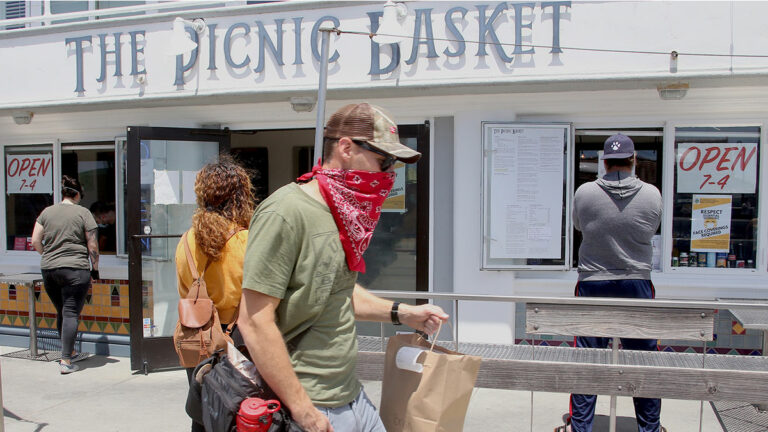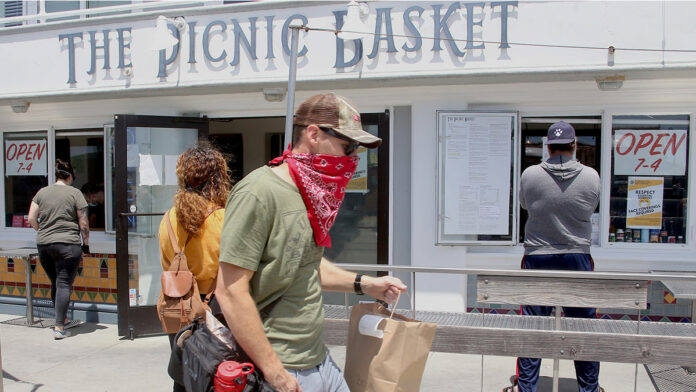After 12 weeks of sheltering in place, the positive health effects on the spread of the novel coronavirus in Santa Cruz County are clear. Santa Cruz County has flattened the curve, greatly slowing the spread of disease.
The mental health effects, however, are less positive and also less understood, says Tim Hartnett, director of Shine a Light Counseling Center, which has offices in Santa Cruz, Watsonville and Monterey.
“People are more stressed and have more severe mental health symptoms or anxiety or depression or substance abuse and more suicidality,” he says.
What makes the current situation more troubling, Hartnett explains, is the fact that—ever since all therapy went online, pivoting to what he calls “teletherapy” appointments—patients have been slower to seek help. “There’s some delay in people seeking treatment,” he says.
Hartnett says some therapists have started doing therapy outdoors as a result. And those who haven’t have begun to feel overloaded when it comes to screen time, he says.
With more industries now opening up, shoppers can now check out local boutiques or set up a haircut appointment. But social gatherings are still verboten, even when it’s just a matter of wanting to go to a friend’s house to watch a movie. “Those things are considered unnecessary and therefore are the last things to be allowed,” Hartnett says. “And yet—if you think about what a social species we are and how important good, connecting activities are to us—that priority comes into question.”
Hartnett says he believes that, in general, many health leaders and politicians underestimated the impact that shelter-in-place orders would have on mental health. He thinks that many experts zeroed in too closely on the virus itself without giving enough thought to what stay-at-home orders would mean for the potential for increased anxiety, depression or substance abuse.
“I didn’t see that concern reflected in what I was hearing from a lot of the policy makers,” he says.
Although he says mental health did not become one of the central talking points in the national discourse, Hartnett says he did hear more concerned discussion about the effects that shelter-in-place orders were having on the economy. (It’s worth noting that, while the cost of shutting down several economic sectors was severe, the nation’s top economists broadly supported government shutdown orders because the economic costs of widespread disease are also severe.)
Given the concerns about jobs, Hartnett adds that the economy is very much tied to people’s moods. A sluggish economy can have deleterious effects on people’s emotional wellbeing, he says. “The amount of stress that people are under—particularly those people who are struggling economically—is having an effect,” he says.
Santa Cruz County leaders certainly have talked about the economic impacts of the shutdown orders. Health Officer Dr. Gail Newel cited them last month when reporters asked her why she was opening up sectors of the economy so quickly, over her own concerns about spread of the virus. “We are trying to walk this very fine line between the very real cost of the economic devastation of our community with the health and safety of the public. So we’re going to give this a try,” Newel said.
Economic slowdowns are quantifiable. What’s more difficult to measure, Hartnett explains, is the direct impact that being ordered to stay home for so long has on the mind.
“What’s extra stressful about the isolation that people are experiencing is we don’t have any way of answering, ‘How long is this going to last?’” Hartnett says. “And that adds an extra layer of stress on top of what was already stressful about being isolated.”
During the height of acrimony over shelter-in-place orders, some mostly conservative activists began holding protests calling for an end to the shutdowns.
Hartnett acknowledges that many of the people protesting on the beaches and in the streets had their own publicly stated rationales for what they were doing. Some used economic arguments to explain why it was time to reopen businesses. Others came armed with conspiracy theories—maybe even like the one of a “plan-demic”—to justify their positions. But Hartnett believes that, regardless of what rationale they may have used publicly, many of those protesters were motivated on a deeper level by their human need to reconnect with others. “Ultimately, I think what drives people to arrive at whatever rationale they have is a need to connect in ways that they haven’t since the beginning of shelter-in-place,” he says.
Hartnett believes no one knows what hindsight will ultimately reveal about the virus, as well as the response from health leaders and governments around the country and around the world. But he isn’t a policy maker, and he says striking the right balance between a community’s physical health needs and its mental health ones is not easy.
Hartnett also does not want to downplay very real risks posed by the virus. Now that some of Shine a Light’s therapists are preparing to go back to work in the office, Hartnett knows that could put them at increased risk for infection. While the therapists and their patients will be wearing required face coverings, he says that sitting in an office with a patient for an hour does pose a risk for exposure.
Going forward, Hartnett says the community also needs to figure out how to better meet children’s needs while keeping them safe. He isn’t sure how to do that, but he says that he knows some kids who have not played with another kid for nearly three months.
He believes that restrictions on outdoor gatherings are important when crowds get big, but nonetheless, he says that, when public parks and beaches are not crowded, they can be vital public spaces—especially because social distancing is easiest to do outdoors and because virus transmission risks are much lower outside.
There’s a chance that the restrictions on beaches could change next month.
Santa Cruz County spokesperson Jason Hoppin says the county intends to keep the existing beach order in place through at least the July 4 weekend and make a decision after that about whether to loosen it or make other changes.
Here are three ideas Hartnett suggests to cope with the negative effects of shelter-in-place:
- Go outside, exercise, and connect with nature.
- Arrange at least one daily social contact, like a check-in phone call, so that you have a chance everyday to tell someone how you are feeling and make a personal connection.
- Within the small bubble of people with whom you do not practice social distancing, try to ask for touch, Hartnett says. In this time, where human touch is so limited, it’s important to make contact with others where it’s available, he says.
More than anything, Hartnett encourages those who need help in these stressful times to seek it out.
“It may be possible to see counselors in person sometimes soon,” he says. “But even until then, it’s better to go ahead and make a call and try to get help—rather than, if you’re cooped up with your family, letting the conflict increase or if you’re in isolation, letting your loneliness and your depression get to a level where it starts to spiral out of control. Better to get help sooner, even if it’s teletherapy. This combination of people’s mental health deteriorating and them delaying treatment is not good. And the thing we can do about it is don’t delay treatment; get help for yourself.”


























